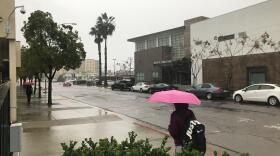The San Diego County Board of Supervisors is set this week to discuss a proposal that would slap new fees on development in car-centric communities, with the goal of incentivizing growth in more urban neighborhoods.
The fees would be calculated based on the additional "vehicle miles traveled," or VMT, that a project would induce. For example, an apartment building in a neighborhood close to public transit and jobs would see little to no fees. A similar project in a rural or car-dependent suburban area would face higher fees, with that revenue supporting bicycle, pedestrian and transit infrastructure.
The policy has been years in the making, as state and local lawmakers seek to discourage the sprawling development that has made transportation California's biggest source of greenhouse gas emissions.
Environmental groups largely support the proposal, arguing it's necessary to ensure the region's growth is focused in more walkable and transit-oriented communities.
RELATED: Housing Crisis Shifts Conversation On Where New Homes Belong
"What we want is for our housing development to align with our transportation objectives and with our climate goals," said Brenda Garcia Millan, research and policy analyst for the nonprofit Climate Action Campaign. "And for that, we need to build smart."
But critics, including the Building Industry Association of San Diego County, argue it would make new housing prohibitively expensive in areas that are currently relatively affordable to the middle class. Supervisor Joel Anderson said at a press conference Monday that the policy would stifle new housing opportunities in his East County district, which includes El Cajon, Poway and Santee.
"We believe that people of color, we believe poor people, all should have an opportunity at homeownership," Anderson said. "It's the American dream, and yet this policy, if mishandled, will deny that dream to all these people."
RELATED: City Council Approves ‘Complete Communities’ Housing Plan
Prior to last year, most cities in California measured a project's transportation impacts based on the additional traffic congestion it would cause. This method, called "level of service," led to counterintuitive results — sprawling development in far-flung areas could be seen as environmentally superior to growth in densely populated urban areas where people are less likely to drive.
Similarly, green transportation projects like bike lanes or roundabouts could be seen as environmentally harmful because they slow down cars. Road widenings to accomodate more vehicle travel were often prescribed as the solution.
Then in 2013 the state legislature passed SB 743, which declared automobile delay was no longer relevant when analyzing a project's environmental impacts. State officials ultimately adopted VMT as the new metric.
The supervisors are expected Wednesday to give county staffers direction on how to incorporate VMT into their future planning. Staffers are floating a range of options, and it will likely be several months before the new policy gets a final vote.






